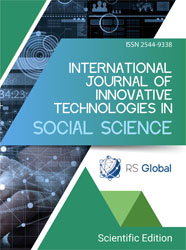THE IMPACT OF EXTERIOR CERAMIC CLADDING AND TRIPLE-GLAZING ON THE ENERGY AND THERMAL ASPECTS OF COLLECTIVE HOUSING IN SKIKDA
Abstract
The interrelated issues of climate change and energy saving have become increasingly significant in the present era and are likely to remain so in the future. This is largely due to the complex and far-reaching impacts these topics have on our society and the environment. Furthermore, these issues align with the needs of people who seek comfort in the indoor spaces where they live or work. In this study, a climatic, energetical and thermal examinations were carried out on a multi-family housing structure in Skikda, basing on actual historical energy data from 2022 for calibration and validation of energy models, using principally CEA and METEONORM tools. This last-mentioned climate simulation tool was also used to generate future meteorological data for 2060 and 2100. Two scenarios were studied: the addition of a ceramic exterior cladding and the replacement of single-glazed windows with triple-glazed windows. The aim was to examine the impact of climate change across three time periods (2022, 2060 and 2100) and the influence of the two techniques on energy efficiency and interior comfort. The results showed that the ceramic cladding reduced electricity and natural gas consumption by 10% and 34% respectively, by insulating the interior from outside temperature variations. Triple-glazed windows reduced natural gas consumption by 27%, but did not reduce electricity consumption due to increased artificial lighting requirements. Analysis of thermal comfort showed that both two intervention scenarios resulted in enhanced conditions. These results are important for guiding energy renovation decisions for buildings in similar climatic zones.
References
Ahmari, I., & Korichi, A. (2019). Simulation de l’impact de l’inertie thermique sur la consommation énergétique d’un bâtiment résidentiel dans un climat méditerranéen. 16.
ANIREF, A. N. d’Intermédiation et de R. F. (2020). MONOGRAPHIE WILAYA DE SKIKDA - Ministère de l’Industrie—Agence Nationale d’Intermédiation et de Régulation Foncière. 29.
Batiactu website. (n.d.). Meteonorm—Logiciel—Batiactu. produits.batiactu.com. Retrieved August 9, 2023, from //produits.batiactu.com/produits/cstb-Editions-logiciel-meteonorm-187592.php
Bekhtache, R. (2012). La transition énergétique via le gaz au service du développement durable en Algérie : Étude analytique sur la période (2000-2014). Journal of Economic Studies, 6(3), 01–13.
Boulkenafet, N. (2014). Gestion et Optimisation de la Réhabilitation Thermique des Bâtiments [Pour obtenir le titre de Magister]. Université 20 Août 1955-Skikda Faculté de Technologie Département de Génie Civil.
Brighet, K. (2018). Etude de l’ambiguïté du statut de l’espace social parties communes dans l’habitat collectif : Cas de Skikda cité du 20aout – cité camus rossi [Thesis]. http://dspace.univ-setif.dz:8888/jspui/handle/123456789/2260
CEA official website. (n.d.). City Energy Analyst. City Energy Analyst. Retrieved February 23, 2023, from https://www.cityenergyanalyst.com
Demougeot-Renard, H. (2016). Qu’est-ce que QGIS et pourquoi se former ? eOde. https://www.eode.ch/2016/05/06/quest-ce-que-qgis-et-pourquoi-se-former/
Hadef, H. (2020). LA VILLE FACE AUX RISQUES : VERS UNE MAÎTRISE DU RISQUE INDUSTRIEL, CAS DE SKIKDA. Revue des Sciences Humaines & Sociales, 6(2), 560–584.
Hong, T., Chen, Y., Luo, X., Luo, N., & Lee, S. H. (2020). Ten questions on urban building energy modeling. Building and Environment, 168, 106508. https://doi.org/10.1016/j.buildenv.2019.106508
Kassis, F. (2012). Haute qualite environnementale dans les espaces domestiques collectifs cas d’étude à skikda [Mémoire pour l’obtention du diplôme de magister en architecture]. Universite ferhat abbas– Setif.
Khelfa, I. eddine. (2024). Hybrid energy renovation of existing buildings: A case study of collective housing in Skikda [Thesis]. http://dspace.univ-guelma.dz/jspui/handle/123456789/16175
Khelfa, I. eddine, Lazri, Y., Alkama, D., & Toumi, R. (2024). An Energy and Ecological Assessment of The Prior and Post-Hybrid Renovation State of Multi-Dwelling Building in the Algerian City of Skikda. Indonesian Journal of Social Science Research, 5(1), Article 1. https://doi.org/10.11594/ijssr.05.01.12
Khelifa, F. (2024). Paramétrage de microclimat urbain par la végétation et les plans d’eau. Cas de la ville Souk Ahras [Thesis]. http://dspace.univ-guelma.dz/jspui/handle/123456789/16198
Khelifa, F., Mahimoud, A., Alkama, D., & Hanafi, A. (2024). The role of trees in enhancing outdoor thermal comfort during warm season in a sub-humid climate. Case: Souk Ahras City. Bulletin of the Serbian Geographical Society, 104(1), Article 1.
Larrère, C. (2009). La justice environnementale. Multitudes, n° 36(1), 156–162.
Latreche, S., & Sriti, L. (2018). Optimisation énergétique d’un bâtiment résidentiel autoproduite à Biskra à travers ses caractéristiques matérielles. Journal of Renewable Energies, 21(3), Article 3.
Palino, G., & Sparks, E. (2021). QGIS: An Introduction to an Open-Source Geographic Information System | Mississippi State University Extension Service. http://extension.msstate.edu/publications/qgis-introduction-opensource-geographic-information-system
Site Climats et voyages, C. du monde. (2020). Climat Skikda : Températures, précipitations, conditions météo prévalentes, quand partir. https://www.climatsetvoyages.com/climat/algerie/skikda
Willmann, A., Katscher, L., Leiser, T., & Voelker, C. (2019). A Comparison of Bottom-up and Top-down Modelling Approaches in Urban Energy Simulation for the Assessment of City District Data Models. 3303–3310. https://doi.org/10.26868/25222708.2019.210424
Views:
86
Downloads:
51
Copyright (c) 2024 Imed Eddine Khelfa, Fatma Khelifa

This work is licensed under a Creative Commons Attribution 4.0 International License.
All articles are published in open-access and licensed under a Creative Commons Attribution 4.0 International License (CC BY 4.0). Hence, authors retain copyright to the content of the articles.
CC BY 4.0 License allows content to be copied, adapted, displayed, distributed, re-published or otherwise re-used for any purpose including for adaptation and commercial use provided the content is attributed.















